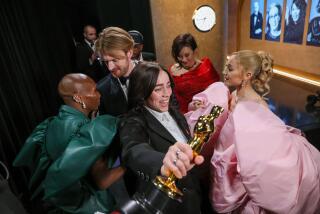Oscars 2013 men’s fashion: Blue hues and skinny ties
No one expected the men walking the red carpet at the 85th Academy Awards on Sunday night to display the same level of colorful plumage as the women, but there were a few fellows who managed to tackle the tux on their own terms and looked dapper as all get out in the process.
Daniel Day-Lewis, who took home the lead actor Oscar, did so wearing a custom-made, navy blue, Domenico Vacca tuxedo with a shawl collar in grosgrain. It was just a subtle-enough shift to signal that Mr. Day-Lewis wasn’t going settle for blending in with his black-clad brethren.
As fate would have it, another of the night’s victors, supporting actor winner Christoph Waltz, also went the navy blue route, his choice a two-button, shawl-collar tuxedo by Prada. Here too the subtle substitution allowed him to be the right kind of sartorial standout.
Unfortunately the same couldn’t be said for Waltz’s “Django Unchained” compatriots. Jamie Foxx chose a gray tuxedo with generous peak satin lapels -- a wardrobe choice that we might’ve applauded had he not paired it with sparkly, black, low-profile bow tie and a black dress shirt that made it hard to tell exactly where the shirt ended and the tuxedo began.
For Quentin Tarantino, who won for original screenplay for “Django Unchained,” it wasn’t the tuxedo that went off the rails but the rail thin necktie -- a long, black leather number that hung loosely knotted far below a sloppy unbuttoned collar. (For the record, Tarantino arrived looking that disheveled.)
It may be “the year of the writer,” as Tarantino proclaimed from the Oscar stage, but judging by the width of that tie, the writer’s neckwear is about 30 years behind.
ALSO:
Red-carpet recap with Adam Tschorn [video]
Oscars 2013: Hairstyles, the long and the short of it
Red carpet swings from old Hollywood to sleek modernity
More to Read
From the Oscars to the Emmys.
Get the Envelope newsletter for exclusive awards season coverage, behind-the-scenes stories from the Envelope podcast and columnist Glenn Whipp’s must-read analysis.
You may occasionally receive promotional content from the Los Angeles Times.







